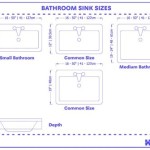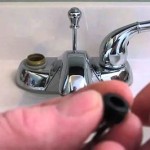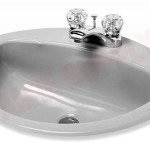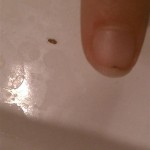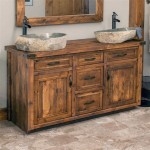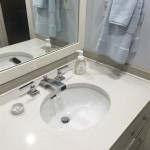Can Bathroom Countertops Be Painted? A Comprehensive Guide
The desire to update a bathroom, particularly its countertops, is a common home improvement goal. Outdated or aesthetically displeasing countertops can significantly detract from the overall appearance of the bathroom. Painting is often considered as a cost-effective alternative to complete replacement. However, the feasibility and long-term success of painting bathroom countertops are contingent on several factors, including the material of the countertop, the quality of the paint and sealant used, and the meticulousness of the preparation and application process.
This article delves into the possibilities and limitations of painting bathroom countertops. It explores the preparatory steps, the types of paint suitable for different countertop materials, the application techniques, and the necessary protective measures to ensure a durable and aesthetically pleasing finish. Furthermore, it addresses the potential drawbacks and provides recommendations for deciding whether painting is the right choice considering the specific circumstances and desired outcome.
Understanding Countertop Materials and Paint Compatibility
The composition of the existing countertop is paramount when considering painting. Different materials react differently to paint, and the adhesion and durability of the paint job will be heavily influenced by this interaction. Common bathroom countertop materials include laminate, ceramic tile, cultured marble, and natural stone. Each material presents unique challenges and requires specific preparation and paint selection.
Laminate countertops, commonly found in older homes, are generally paintable. However, the smooth, non-porous surface requires careful preparation to ensure proper adhesion. Roughing up the surface with sandpaper is crucial to create a mechanical bond between the laminate and the primer. Furthermore, using a high-quality primer designed for non-porous surfaces is essential. Without proper preparation and the right primer, the paint is likely to chip and peel over time, especially in a high-moisture environment like a bathroom.
Ceramic tile countertops, characterized by grout lines, present a more complex challenge. While the tile itself can be painted, the grout lines pose a significant hurdle. Achieving a smooth, uniform finish over uneven grout lines is difficult. Additionally, grout is porous and can absorb moisture, potentially leading to paint peeling or discoloration. Special epoxy-based paints designed for tile and grout can be used, but meticulous cleaning and preparation are crucial for success. Furthermore, consider whether the aesthetic of painted tile with potentially visible grout lines aligns with the desired outcome.
Cultured marble, a composite material made from crushed stone and resin, is often paintable. Its relatively smooth surface allows for good adhesion, provided the surface is properly cleaned and primed. Light sanding is generally recommended to create a slightly rougher surface. However, it is important to identify the specific type of cultured marble as some formulations may react differently to paint. Consulting with a paint specialist or testing a small, inconspicuous area is advisable.
Natural stone countertops, such as granite or marble, are generally not recommended for painting. These materials are porous and susceptible to staining. While it is possible to paint them, the paint is unlikely to adhere well and may eventually peel or chip. Furthermore, painting natural stone can diminish its inherent beauty and value. If the appearance of a natural stone countertop is undesirable, alternative options such as polishing, resealing, or complete replacement are typically more suitable.
Preparing the Countertop for Painting: A Critical Step
Proper preparation is arguably the most crucial aspect of a successful countertop painting project. Insufficient preparation will inevitably lead to premature paint failure, regardless of the quality of the paint used. The preparation process involves cleaning, sanding, and priming, each serving a distinct purpose.
Thorough cleaning is the first step. Any dirt, grease, soap scum, or other contaminants must be completely removed from the countertop surface. A degreasing cleaner specifically designed for the countertop material is recommended. After cleaning, rinse the surface thoroughly with clean water and allow it to dry completely. Any residual contaminants will prevent proper paint adhesion.
Sanding is essential for creating a slightly rough surface that allows the primer and paint to adhere effectively. The grit of sandpaper used will depend on the countertop material. For laminate or cultured marble, a medium-grit sandpaper (around 120-180 grit) is typically recommended. For ceramic tile, a coarser grit sandpaper (around 80-100 grit) may be necessary to create sufficient texture. Sand the entire surface evenly, paying particular attention to edges and corners. After sanding, remove all sanding dust with a tack cloth or a vacuum cleaner with a brush attachment. Failure to remove sanding dust will result in a textured paint finish and compromised adhesion.
Priming is a crucial step that creates a bond between the countertop surface and the paint. Select a high-quality primer specifically designed for the countertop material. For example, a bonding primer is recommended for laminate, while an epoxy primer may be suitable for ceramic tile. Apply the primer evenly, following the manufacturer's instructions. Two coats of primer may be necessary for optimal coverage and adhesion. Allow the primer to dry completely before applying the paint. Proper priming ensures a uniform paint finish and long-lasting durability.
Selecting the Right Paint and Sealant for Durability
The choice of paint and sealant is critical for ensuring the longevity and aesthetic appeal of the painted countertop. The bathroom environment presents several challenges, including high humidity, frequent exposure to water, and potential exposure to cleaning chemicals. Therefore, selecting paints and sealants specifically formulated for these conditions is essential.
Epoxy paints are often recommended for bathroom countertops due to their durability and resistance to moisture and chemicals. Epoxy paints form a hard, durable finish that can withstand the rigors of a bathroom environment. However, epoxy paints can be more difficult to apply than other types of paint and may require multiple coats for optimal coverage. Furthermore, epoxy paints typically have a strong odor and require adequate ventilation during application.
Acrylic latex paints, particularly those formulated for kitchens and bathrooms, are another viable option. These paints offer good adhesion, durability, and moisture resistance. They are also easier to apply than epoxy paints and have a lower odor. However, acrylic latex paints may not be as durable as epoxy paints and may require more frequent touch-ups. Choosing a high-quality acrylic latex paint specifically designed for high-moisture environments is crucial.
Regardless of the type of paint chosen, applying a topcoat or sealant is essential for protecting the paint finish and enhancing its durability. Polyurethane sealants are a popular choice for bathroom countertops due to their resistance to moisture, chemicals, and scratches. Apply the sealant in thin, even coats, following the manufacturer's instructions. Multiple coats of sealant may be necessary for optimal protection. Ensure the sealant is completely dry before using the countertop. The sealant acts as a barrier, preventing water and chemicals from penetrating the paint and causing damage.
Consider the sheen level when selecting paint and sealant. A higher sheen level, such as semi-gloss or gloss, is generally preferred for bathroom countertops because it is more resistant to moisture and easier to clean. However, a higher sheen level can also accentuate imperfections in the countertop surface. A lower sheen level, such as satin or eggshell, may be more forgiving of imperfections but may be less durable and more difficult to clean.
When painting ceramic tile countertops, specialized tile and grout paints are available. These paints are typically epoxy-based and formulated to adhere to the smooth, non-porous surface of tile and the porous surface of grout. However, these paints can be challenging to apply and may require specialized tools and techniques. Carefully follow the manufacturer's instructions for best results.
In summary, selecting the right paint and sealant is crucial for achieving a durable and aesthetically pleasing finish on bathroom countertops. Consider the countertop material, the bathroom environment, and the desired aesthetic when making your selection. Always follow the manufacturer's instructions for application and drying times.

Paint Bathroom Vanity Countertop Sink So Easy A Piece Of Rainbow

How To Easily Spray Paint Bathroom Countertops My Homier Home
:strip_icc()/101922779-2cbc45e123c34827afb4f601723b03ca.jpg?strip=all)
How To Paint Bathroom Countertops

Paint Bathroom Vanity Countertop Sink So Easy A Piece Of Rainbow

How To Paint A Countertop Don T Make These Mistakes Blessed Beyond Crazy

How To Paint Tile Countertops And Our Modern Bathroom Reveal Bright Green Door

Should You Be Painting Your Bathroom Countertops Caesarstone

How To Easily Spray Paint Bathroom Countertops My Homier Home

Can You Paint A Countertop Re Sick Of Absolutely Recreated Designs

How To Paint A Countertop Don T Make These Mistakes Blessed Beyond Crazy
Related Posts
